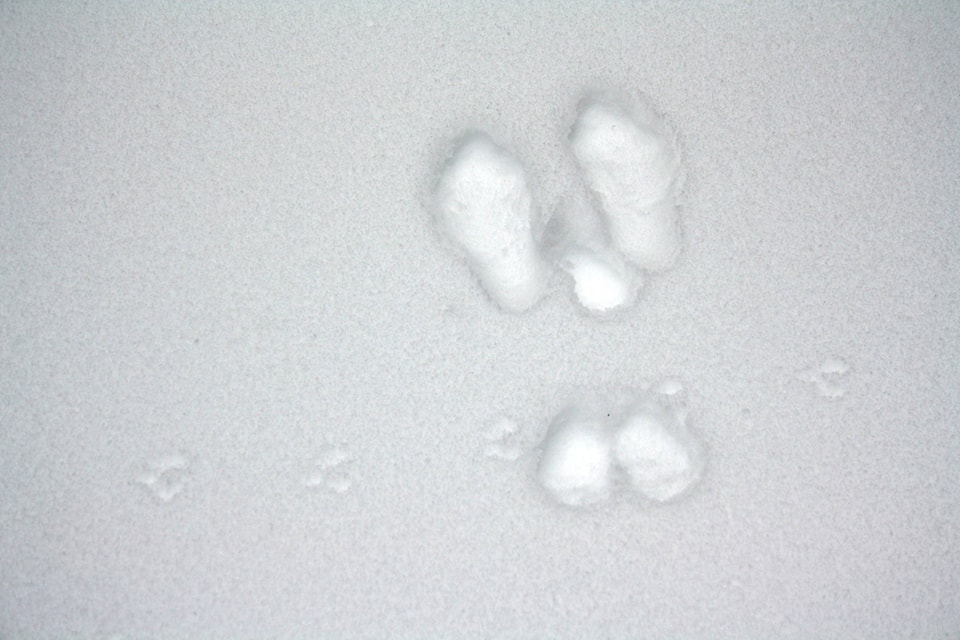Tracking is an exciting and marvellous way to discover wildlife in their natural environment.
And snow is ideal for tracking; a record is impressed wherever wildlife move, hunt, feed, rest or sleep. Snow also reveals and highlights wildlife signs such as climbing scars, rubs and scratches on trees.
Look for scent-marks (pee), scats (poop) and feeding signs like clipped conifer cones, gnawed seeds and nipped-off vegetation. These are all tracking signs.
Tracking is primarily following footprints in a line. They reveal how slow or fast an animal is travelling, what it’s doing or thinking and where it’s going and why.
Just remember: wildlife find their own food, water, shelter and need space; that’s what makes them wild.
Experience the wild winter wonderland, and observe and inspect wildlife signs while snowshoeing. February is the best time to track as the winter days warm and lengthen.
By then the snow is usually nicely settled for easier snowshoeing and new snowfalls show off tracks clearly. Fluffy or melting snow distorts tracks.
Most wildlife avoids deep, fluffy snow that’s too difficult to travel through.
Like us, wildlife prefers to follow pathways making travel much easier.
Head up to Silver Star or Sovereign’s trails for great tracking experiences and see if you can identify the wildlife tracks. Morning treks might reveal a host of nocturnal travellers.
For help, ask a naturalist, hunter or nature-loving friend about wildlife in the area. If you’re lucky, maybe there’s a book, pamphlet or website featuring the wildlife.
Check the library or online for a good winter wildlife field guide. Write a list of wildlife for the area. This helps keep it fresh in your mind and a quick reference.
Then head out to explore and watch for signs. A whole new world of discovery will open up to you. Find something you want a photograph? Place your hand, finger or a coin next to the track, scat or sign to show its size.
Stop, look and listen. Move slowly and keep your eyes open, ears cocked and even sniff. Notice disturbances like digs and holes in the snow or feeding signs.
Listen for branches snapping, scratching or anything unusual.
Look up, down and under, then take a closer look. Slow down and double-check. Be curious. When you see a sign, ask: What is this? What happened here? What could it be? Why? Where did it go? Wake up your instincts. We’ve been living with wildlife for millennia. If you suspect something, check it out.
Birds generally feel safe being seen. And often their nests in trees or shrubs are obvious.
But other wildlife either camouflage or hide from people, are nocturnal or are scarce. They may be hiding in the snow, on the other side of a tree, etc. Stay still and you may see them come out.
Look for subnivean (under snow) entry holes beside tree trunks or near bent over, snow-covered shrubs which look like bumps on the undulating snowy landscape. And realize there’s a whole busy community thriving in tunnels and pockets under your trail. Of course, you can’t see the subnivean environment, so while snowshoeing let your eyes sweep over the snowy landscape looking for holes.
These are the wildlife passages into the subnivean habitat. Imagine the world underneath. If it’s warm enough, stay still for a few minutes. You may be lucky enough to catch the hidden comings and goings. Good luck! Have fun being a wildlife detective!
For the Record from January column: Dams prevent our big lakes from receding or evaporating away.
Roseanne enthusiastically shares her knowledge of the outdoors to help readers experience and enjoy nature. Follow her on Facebook.
